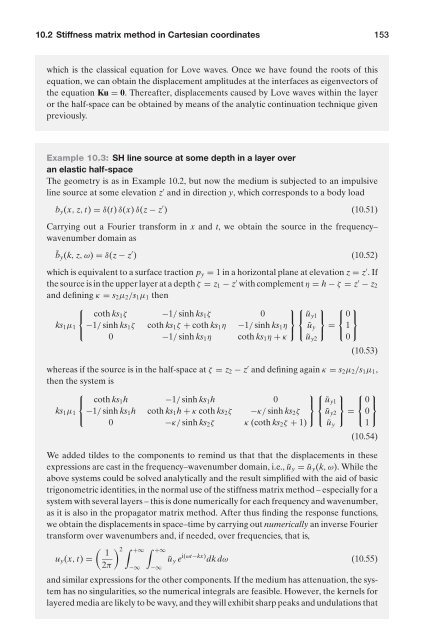Eduardo Kausel-Fundamental solutions in elastodynamics_ a compendium-Cambridge University Press (2006)
You also want an ePaper? Increase the reach of your titles
YUMPU automatically turns print PDFs into web optimized ePapers that Google loves.
10.2 Stiffness matrix method <strong>in</strong> Cartesian coord<strong>in</strong>ates 153<br />
which is the classical equation for Love waves. Once we have found the roots of this<br />
equation, we can obta<strong>in</strong> the displacement amplitudes at the <strong>in</strong>terfaces as eigenvectors of<br />
the equation Ku = 0. Thereafter, displacements caused by Love waves with<strong>in</strong> the layer<br />
or the half-space can be obta<strong>in</strong>ed by means of the analytic cont<strong>in</strong>uation technique given<br />
previously.<br />
Example 10.3: SH l<strong>in</strong>e source at some depth <strong>in</strong> a layer over<br />
an elastic half-space<br />
The geometry is as <strong>in</strong> Example 10.2, but now the medium is subjected to an impulsive<br />
l<strong>in</strong>e source at some elevation z ′ and <strong>in</strong> direction y, which corresponds to a body load<br />
b y (x, z, t) = δ(t) δ(x) δ(z − z ′ ) (10.51)<br />
Carry<strong>in</strong>g out a Fourier transform <strong>in</strong> x and t, we obta<strong>in</strong> the source <strong>in</strong> the frequency–<br />
wavenumber doma<strong>in</strong> as<br />
˜b y (k, z,ω) = δ(z − z ′ ) (10.52)<br />
which is equivalent to a surface traction p y = 1 <strong>in</strong> a horizontal plane at elevation z = z ′ .If<br />
the source is <strong>in</strong> the upper layer at a depth ζ = z 1 − z ′ with complement η = h − ζ = z ′ − z 2<br />
and def<strong>in</strong><strong>in</strong>g κ = s 2 µ 2 /s 1 µ 1 then<br />
⎧ ⎫ ⎧ ⎫ ⎧ ⎫<br />
⎨ coth ks 1 ζ −1/ s<strong>in</strong>h ks 1 ζ 0 ⎬ ⎨ ũ y1 ⎬ ⎨ 0 ⎬<br />
ks 1 µ 1 −1/ s<strong>in</strong>h ks<br />
⎩<br />
1 ζ coth ks 1 ζ + coth ks 1 η −1/ s<strong>in</strong>h ks 1 η ũ<br />
⎭ ⎩ y<br />
⎭ = 1<br />
⎩ ⎭<br />
0 −1/ s<strong>in</strong>h ks 1 η coth ks 1 η + κ ũ y2 0<br />
(10.53)<br />
whereas if the source is <strong>in</strong> the half-space at ζ = z 2 − z ′ and def<strong>in</strong><strong>in</strong>g aga<strong>in</strong> κ = s 2 µ 2 /s 1 µ 1 ,<br />
then the system is<br />
⎧ ⎫ ⎧ ⎫ ⎧ ⎫<br />
⎨ coth ks 1 h −1/ s<strong>in</strong>h ks 1 h 0 ⎬ ⎨ ũ y1 ⎬ ⎨ 0 ⎬<br />
ks 1 µ 1 −1/ s<strong>in</strong>h ks<br />
⎩<br />
1 h coth ks 1 h + κ coth ks 2 ζ −κ/s<strong>in</strong>h ks 2 ζ ũ<br />
⎭ ⎩ y2<br />
⎭ = 0<br />
⎩ ⎭<br />
0 −κ/s<strong>in</strong>h ks 2 ζ κ(coth ks 2 ζ + 1) ũ y 1<br />
(10.54)<br />
We added tildes to the components to rem<strong>in</strong>d us that that the displacements <strong>in</strong> these<br />
expressions are cast <strong>in</strong> the frequency–wavenumber doma<strong>in</strong>, i.e., ũ y = ũ y (k,ω). While the<br />
above systems could be solved analytically and the result simplified with the aid of basic<br />
trigonometric identities, <strong>in</strong> the normal use of the stiffness matrix method – especially for a<br />
system with several layers – this is done numerically for each frequency and wavenumber,<br />
as it is also <strong>in</strong> the propagator matrix method. After thus f<strong>in</strong>d<strong>in</strong>g the response functions,<br />
we obta<strong>in</strong> the displacements <strong>in</strong> space–time by carry<strong>in</strong>g out numerically an <strong>in</strong>verse Fourier<br />
transform over wavenumbers and, if needed, over frequencies, that is,<br />
( ) 1 2 ∫ +∞ ∫ +∞<br />
u y (x, t) =<br />
ũ y e i(ωt−kx) dkdω (10.55)<br />
2π −∞ −∞<br />
and similar expressions for the other components. If the medium has attenuation, the system<br />
has no s<strong>in</strong>gularities, so the numerical <strong>in</strong>tegrals are feasible. However, the kernels for<br />
layered media are likely to be wavy, and they will exhibit sharp peaks and undulations that



